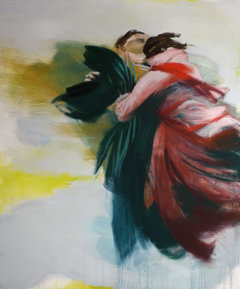Helene Picard
dal 15/2/2008 al 21/4/2008
Segnalato da
15/2/2008
Helene Picard
Museo del Traje, Madrid
The French artist presents her latest project, Frameworks, in the Museum of Costume, bringing together painting and dress. Along a route with different stages, the artist creates a special plastic and poetic ensemble. What she attempts to show here is how art and couture can complement each other and how a painting can express our inner world through material, form, colour and design.

The French artist Hélène Picard, based in Madrid since 2000, presents her latest project, Frameworks, in the Museum of Costume, bringing together painting and dress.
Along a route with different stages, the artist explores the relationships between painting and dress, and creates a special plastic and poetic ensemble the spectator can wander through. What she attempts to show here is how art and couture can complement each other and how a painting can express our inner world through material, form, colour and design.
Starting from the flat pattern shape which is transformed into volume, the exhibition gradually develops a storyline where the costume, a sort of pictorial sculpture, turns into the outer wrappings of the characters emerging from the paintings; through the vigorous brush strokes and figures in movement the paintings lead us to a sensation of happiness or into the unknown.
This means that dress linked with painting takes on a plastic, timeless dimension while still being clothes on a human scale, and the viewers can identify themselves and enter into the more abstract world of painting, to take part in weaving new emotional and poetic strands.
With the collaboration of Casa de Velázquez, Obra Social Caja de Burgos, Rina Bouwen Gallery and Textil Olius S.A.
Until 2 March 2008
Paper cutouts
Like every year the Museo del Traje will exhibit one of its hidden collections: cutouts are the leading actors of this year.
Cutouts can be sometimes real master pieces of the typographic printing besides they’re one of the simplest kind of toys.
Scope of this exhibition is to give a general view of the museum’s cutouts collection and to emphasize its most valuable items: the ones with war contents (the “fulls de rengle” and the armaments cutouts) as well as the dolls with their trousseaus, some games and the paper theatres.
All of them are just “papers” which have transformed into something else, have gained our utmost consideration as valuable collection items with high anthropological value.
Until February 2008
Women in withe
Along the history of the different cultures the wedding dress has shown a wide diversity in shapes and styles, following the evolution of fashion itself. Designed for a single, brief moment, it has been influenced by the social and technological changes, also acting as testing field, in which many formal innovations have developed.
In the past, the wedding dress was handmade. This situation changed when the designers and their brands started to be famous and got settled in the market. This structure would live with the haute couture and fall, giving way to a specialization in the field, to the industrialization of production and finally to the role Spain plays in this fashion sector.
The Museum of Costume owns a wide collection of wedding dresses from the XIX, XX and XXI centuries, mostly received as donations along the life of this institution.
With the aim to diffuse the history of fashion in Spain by means of the wedding dress and some pieces of international brands the Museum of Costume presents Women in White, thirty five dresses of the XIX and XX centuries and a video showing the pieces which cannot be on show due to the lack of space.
The Museo del Traje. Centro de Investigación del Patrimonio Etnológico
Avenida de Juan de Herrera, 2. Madrid (28040)



